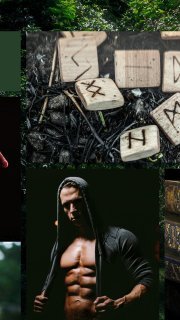C.M. Rosens's Blog, page 40
March 25, 2021
Podcast S01E08 ~ Chapter 7 Up Now!
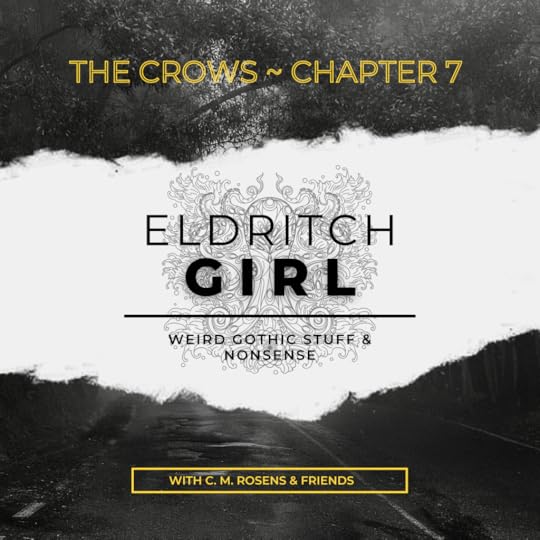
THE END OF PART 1 IS UP! Chapter 7 is the last chapter of Part 1. Listen to it here.
CHAPTER 7: REAL AFTER ALL
Chapter 7: Real After All…in which Mercy shares a secret…
Ricky closed up the trapdoor after himself and trudged upstairs to his own room, filling his lungs with fungal moistness. The wrought-iron bedframe of his childhood bed was a fraction too short even for him, and, after stripping off at the door, rubbing his flat, muscular belly as something rippled inside, he assumed his usual foetal position on the stained mattress. Lying in the dark with his head pillowed in the crook of his own arm, a thin brown blanket only half his length pulled over his naked skin, he listened.
C. M. Rosens, The Crows, p. 138
His own breathing filled the room.
There was a suck of skin as his other lips parted, mucus-slick, the scratching quest of his air-roots as they coiled up from inside him, squeezing their way along his spine and twanging his oesophagus on their way out. The mattress behind his head felt spongey, tasted sour under the tongue-like lengths as they spread out behind him, seeking protein.
And that’s all for Part 1 of The Crows… but we’ll be back for Part 2 next week, at the usual time. In the paperback, you get a lovely illustration for each section drawn by Tom Brown. There are 3 in the ebook and 5 in the paperback. Check out the Gallery page for examples!
Do you want to chat about the story so far? You can head on over to the Goodreads group, Pagham-on-Sea Tourist Board, and chat there! You can also @ me on Twitter or Instagram and use #TheCrows for related discussions.
March 22, 2021
Bonus Episode ~ The Sound of Darkness
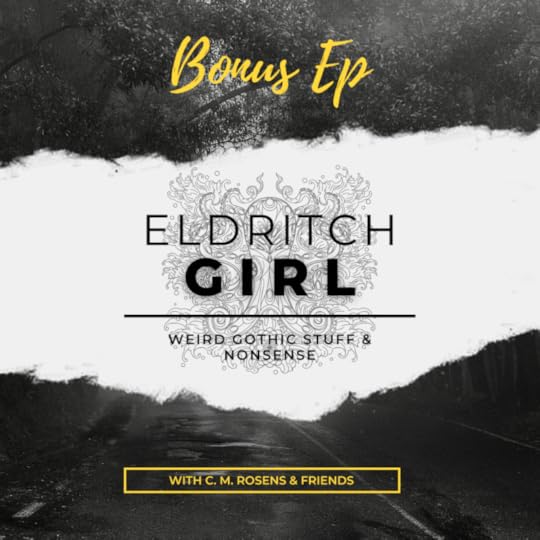
The bonus episode for March is my short story, ‘The Sound of Darkness’, published in ‘F is for Fear’ by Red Cape Publishing.
Listen now on my podcast page.
The Sound of DarknessCORRECTION: at one point, I should have said ‘through the door leading to the lifts’, rather than ‘into the lifts’, because Peregrine House has the lifts on a different corridor to the stairs. They then have to wait for a lift. (Lift = elevator). Hopefully you get what I meant!
This one is a bit more personal as a story, and deals with not really being in touch with your heritage and family history, and having other people’s views of you being superimposed on who you’re trying to be. It’s a story about growing up in the 90s, childhood terrors, and self-acceptance, even of the parts of you that you don’t fully understand. I gave the main character a Turkish name and heritage to mirror mine, and the erasure of that heritage and its dismissal by other people is something that perhaps the darkness is analogous of, perhaps not.
While it’s meant to be a ‘horror’ story, I think it’s more a Weird story, as there is no easy answer as to what the protagonist saw or thought he saw as a thirteen-year-old.
You can pick up a copy of the anthology here, or add it to Goodreads.
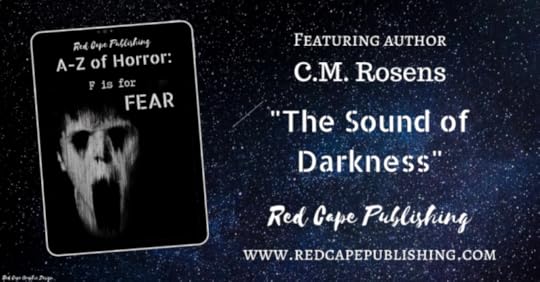
March 20, 2021
Wintry Wiltshire Gothic ~ in pictures
The Ancients’ Lost Guide To Live Tweets
Kidding. But now I have your attention, here are some tips and tricks to make your online event more accessible, and to get the most out of online engagement!
Friday 26th March 2021 I’m going to do a sponsored tweetathon to raise money for the Romancing the Gothic project. The goal is to try and hit the £500 target, or at least contribute a fair way towards it. The money raised will go towards the costs of the paid-for Zoom platform, WordPress Premium fees and assorted admin costs, compensating Sam for their time if possible, but mainly towards giving speakers a fair fee for their time and expertise, particularly scholars in precarious employment.
I’m going to play all the talks I’ve missed back to back, and do a tweet thread on each one in real time, as I listen, without pauses. By this, I mean that I will basically be note-taking via tweets.
I will allow myself 60mins total breaks through the day (to include toilet breaks) but the rule is that I cannot pause in the middle of a thread, only between them. My playlist currently has 13 talks, and that means if I get through them all, it will be 13 hours of tweeting. o.O I managed 8 last time.
Donate directly to Sam’s Ko-Fi, with the note #RtGMarathon2.
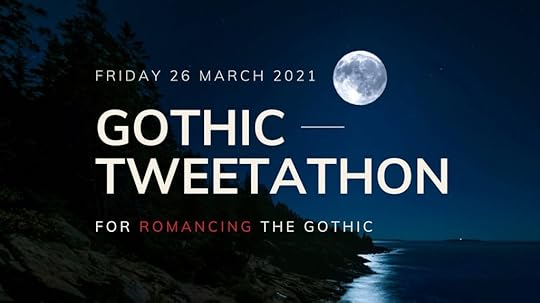
Live-tweeting is a skill that improves with practice, and there are many reasons to develop it and to get an experienced, designated live-tweeter to cover events and talks if you’re thinking about accessibility.
Many events have moved online in a hurry since the pandemic began, and others are slated to continue being streamed or blended in the future. With the advent of more online conferences and lectures than before, there is a greater accessibility potential, too.
I started live-tweeting conferences when I was newer to Twitter, at a conference, and my pen ran out. How was I going to continue taking notes? I tried my note app but struggled with the interface. My brain works better when it’s parsing and filtering info very quickly, and I noticed that people were tweeting about the talks we were at (the speakers had said this was fine). So I started tweeting my notes instead. This was back in the day when tweets were 140 characters, but I already had my own personal shorthand for notes which was based on mainstream text abbreviations.
Fast forward to today, and with a lot of practice, here are some examples of my live-tweet threads:
Don't forget that if you want to listen to Dylan Trigg's lecture on philosophy and horror it is TONIGHT (Friday 12 Feb) at 7pm GMT.
— C. M. Rosens (@CMRosens) February 12, 2021
I will ask if I can live tweet as usual, but as usual won't assume the speaker will be ok with it so we will see! #RomancingtheGothic
Super excited for today's #BodyHorror talk from #RomancingtheGothic with Jon Greenaway @TheLitCritGuy!!
— C. M. Rosens (@CMRosens) March 6, 2021
B O D Y H O R R O R
If you can support this, you can tip our speaker here: https://t.co/EqmHcn0Ude
In the #RomancingtheGothic talk by Julia Ftacek (she/her) @JuliaFtacek on BYRON'S "MANFRED" AND THE TRANSGENDER SELF.
— C. M. Rosens (@CMRosens) December 20, 2020
This is a 1hr Sunday Gothic talk so here we go, discussing Romanticism and this Byron played.
CWs for suicide, transphobia, HIV/AIDS
I do this for free as a means of note-taking where Romancing the Gothic is concerned, and as I go to pretty much every talk, it’s become a Thing. Obviously I miss some talks, and I’m going to marathon these on Friday 26th March 2021 using the hashtag #RtGMarathon2 to raise money for the project. Last time I did 8 threads over about 8 hours without a break in a tweetathon to raise money for Umbrella Cymru, and you can find those threads using the tag #RtGMarathon.
Planning For Live TweetsIf you want your event to be live-tweeted, it helps a lot to plan this in advance, and I shall tell you for why.
Check in advance if your speakers are ok with their work going online in short form. They may not be if they intend their paper to only reach the immediate audience of ticket holders, and not a wider audience who are unfamiliar with their work. If they are testing out a theory on their audience of peers, for example, they may not want this to be taken out of context by the general public who can access the tweet version. Additionally, if the tweet-thread isn’t contextualised like this, then any errors they make or any issues with their methodology can be picked apart by strangers online, and are now a matter of public record that can be found by others – employers, students, peers, etc – with a simple search. If your speakers are fine with it, or are fine but with some caveats (e.g. “please don’t tweet pics of the images on my slides, as that may have copyright implications”), you can put this in the programme itself for everyone to know. Alternatively, you can mark people who do not want their papers live-tweeted with a simple sign next to the paper title (explain in the front of the programme the policy on live-tweeting and accessibility, so people know what’s what!) no live-tweets please we’re British
no live-tweets please we’re British2a. Setting up is much easier if you have a designated live-tweeter who has access to PowerPoint slides and speaker info beforehand. It’s a lot easier to just copy/paste info into a tweet. Same goes for keywords and key names in the presentation that the live-tweeter needs to know how to spell! Sometimes the slides click onwards quickly and you’re still trying to tweet the previous one. So if all the info is available on the slides themselves, having the powerpoint slides sent to the live-tweeter before the talk is also a big help.
2b. If there are images that it’s fine to tweet out, then sending .jpg or .png copies to the live-tweeter and having pre-prepared alt-text to copy and paste into the description box [up to 1000 characters per image] makes that far more accessible for people with screenreaders.
3. The intro tweets: what to include!
The Event’s hashtag so people can find the thread easily. If there are multiple panels, good practice is to add in the panel number. For example, for the upcoming Romancing the Gothic conference celebrating the Centenary of Georgette Heyer’s novel, The Moth, there will be 3 panels of 20min papers throughout the day, plus a session of ‘lightning talks’. #BlackMoth100 #S1 If you search for #BlackMoth100 you’ll now get a feed of every tweet using that tag. If you search for #BlackMoth100 + #S1 you’ll get a feed for Session 1 tweets. You can also make it easier to search for a specific paper: #S101 for paper 1 of session 1. Try to keep tags short to maximise room for actual tweeting!The Session/Panel title What to expect from the thread. Start with an introduction that lists the speakers, their honorifics and pronouns, their institutional or business or centre affiliation [or if they are independent scholars or equivalent in their field] and their paper titles.You can then link anything relevant such as publications, posts, profiles and websites, or if appropriate, buy links. Here’s a messy example::Books by Dylan Trigg:
— C. M. Rosens (@CMRosens) February 12, 2021
-The Aesthetics of Decay (2006)
-The Memory of Place: A Phenomenology of the Uncanny (2012)
-The Thing: A Phenomenology of Horror (2014)
-Topophobia: A Phenomenology of Anxiety (2016)
If you want to support the project @GothicRomancing you can do so by becoming a Patreon or giving a monthly donation of your choice on Ko-Fi to the project lead, facilitator and organiser, @RomGothSam https://t.co/lUV42tM51q https://t.co/KxD9qWKiK0
— C. M. Rosens (@CMRosens) February 12, 2021
#BlackMoth100 – intro thread to whole event – generic info goes in this thread. Here’s the programme image! (tweet a pic of the programme, describe the image in alt-text) The following will not be live-tweeted: [say who, no need to say why]. Rules – e.g. asking that people don’t use an unroll app on the threads?* Ticket sales still open? Can people tweet questions during the conference if they are not participating via tickets? Where to support?
Explain the hashtag system to other tweeters and readers. What tags and @s do you want people to use? This helps to keep everything coherent and all tweets will appear on one feed.
How is this going to look in practice? Here’s an idea:
New thread:
#BlackMoth100 #S1 – recap the content of the session, the speakers.
You can keep this as one master thread for the session, and then when it begins, add this into the thread like : #BlackMoth100 #S101 > First Speaker. Thread. #BlackMoth100 #S102 > Second Speaker. Thread. #BlackMoth100 #S103 > Third Speaker. Thread.
People wanting to read S1 all the way through can find that session easily. If they are looking for a specific speaker, they can do that via that speaker’s tag. You don’t need to have it set up like this, do what makes sense for your event and its audience.
Example:
#IMC2017 #s1444 one #histfic author began writing as a way to present history more engagingly for his high school students; others share too
— Dr Melissa Julian-Jones (@MedievalMJJ) July 5, 2017
*Unroll apps can sell the data they collect from unrolling, and circulate it without credit. Be careful with these in general. If this is a cause of concern to your speakers, then that’s another reason they may not wish to be live-tweeted. Explicit permission is a must.
5 Dos and Don’tsDO figure out a consistent shorthand for your tweets with abbreviations that will be easy to understand in context. If you want to abbreviate things on the fly, write out in full and put the abbreviation [in brackets] after it, then continue. DON’T break the thread! If you do, link the next tweet in the sequence.Sorry broke the thread next tweet here https://t.co/7OBAWWsn8G
— C. M. Rosens (@CMRosens) February 6, 2021
3. DON’T worry if life interrupts you. That happens. If you miss some stuff, apologise, let people know the errors are yours not the speaker’s, and continue! IDEALLY, set yourself up in a cosy space, go to the toilet beforehand, shut the door, headphones on, feet up, crack on. Whatever works for you.
-What do you think of SOCIETY?
— C. M. Rosens (@CMRosens) February 12, 2021
:: preempts 90s critique of the excesses of the 80s and the individualism of it
[Sorry interrupted briefly by husband asking if I want a cup of tea so I missed some of this]
4. DO try to focus on the main points, paraphrase, and link to other stuff that your readers might be interested in.
5. DO include support links like PayPal, CashApp, Venmo, Ko-Fi etc if appropriate. Let people know where to support the speaker and the event for each thread you do.
Most Importantly…Have fun!
Good luck!
March 18, 2021
Podcast S01E07 ~ Chapter 6 [Part 2 of 2] Up Now!
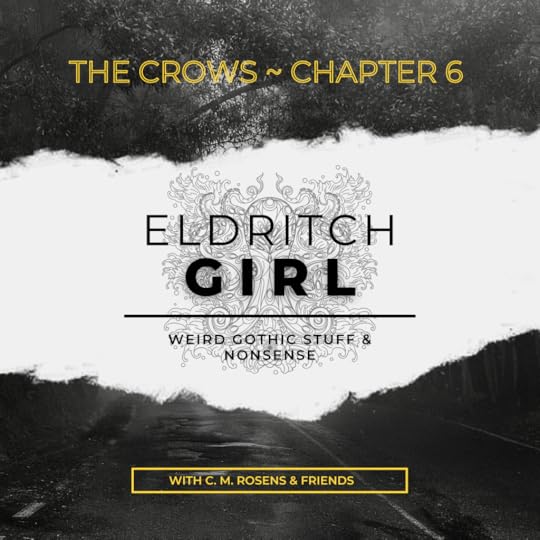
Part 2 of Chapter 6 is now up! We pick up from the cliffhanger of last week… continue listening on the podcast.
CHAPTER 6: BE CAREFUL WHAT YOU WISH FOR (PART 2 OF 2)
Chapter 6: Be Careful What You Wish For(Part 2 of 2)
Carrie quickly learned there was nothing like disposing of a body to bind relative strangers.
C. M. Rosens, The Crows, p. 128
If you’re enjoying this and you want to read ahead, please go for it, and buy the book! The podcast episodes are word-for-word from the book, so go ahead and buy it if you want transcripts of the story so far… You can grab your paperback copy from Amazon UK or Amazon.com, and the ebook from any retailer of your choice or direct from my Ko-Fi shop!
Join the discussion on Goodreads in the Pagham-on-Sea Tourist Board group!
March 15, 2021
NEW SHORT STORY!
Announcing a new short story featuring characters that appear in The Crows and forthcoming novel Thirteenth – a tragic, twisted romance, ‘Overexposure‘. It’s more obsession than romance, but Charlie and Wes’s relationship is a complex one and this is where it started.
If you want to read a ‘final.1’ draft for free, then you can subscribe to my newsletter (Issue 2 has the free version, which went out to subscribers today, but I think as a subscriber you get access to my back catalogue). Review on Goodreads please, if you read it for free!
A dark, twisted, tragic romance for horror fans
When Charlie, an affluent, award-winning photographer, catches sight of a glamorous man at a party and immediately forgets what he looks like, she has to see him again. And again. And again. When he realises the extent of her obsession, is it already too late?
CW: self-mutilation, gore, mental health deterioration
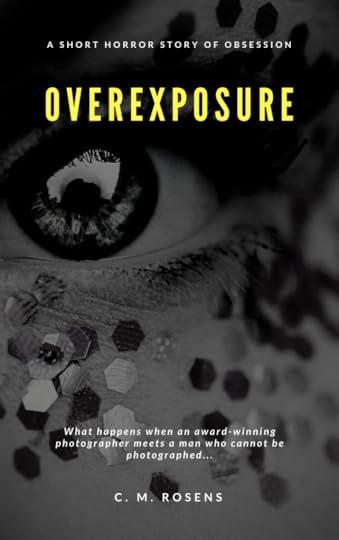 Cover by C. M. Rosens
Cover by C. M. RosensThe first time she saw him was through the lens of her camera, the way she saw most of the world. Her mother joked the lens was her third eye, since she was hardly ever without it. Charlie had long ago embraced the fact she saw things the way others did not. So, when she took his picture for the first time then immediately forgot what he looked like, she had to take his picture again. And again.
~ C. M. Rosens
He was a guest in the whirl of disco lights and ice sculptures, but as soon as the shutter clicked he was a shadow-presence, there, but intangible. A disembodied silk shirt covered in a pattern of stylised peacocks and interwoven with gold thread. Designer jeans of indeterminate length or shape. A faceless, glamorous ghost. He was exactly what she had been trying to capture for years but didn’t have the words to explain.
Charlie had won her first photography prize aged seven, when her father’s camera was too heavy for her and she’d had to rest it on the garden wall at their holiday home in Devon that she was almost too short to see over. Her work had tried to capture that ever since: something on the edge of vision, something beyond her limited perspective. Taking promo photos for launch events wasn’t really what she wanted to do, but it boosted her profile and meant she could keep the business going without parental help. Charlie knew she was lucky to have her parents and their backing, and a nice house in Chelsea, and that she could afford to pursue her passion full-time. Her grandfather had made the family money, but Charlie had never needed to work the way he had. As far as she was concerned, the carefully cropped and edited family memories of Before – before grandfather, before the good schools and the good jobs and the first and second homes and the savings accounts – were all of the story she needed to know. She filed them away and went on with living her life, the only one she knew or understood. Her world was telescoped, fragments in a dark room, digital images manipulated with tints and filters, and every experience she ever had was recorded in pictures with compulsive fervour. She wasn’t equipped for the man who wasn’t there, who resisted record and perforated her memory with magnetic emptiness.
Preorder here: https://books2read.com/u/b5v2Vw
Smashwords [epub format only]
OR
Buy direct from my Ko-Fi Shop [epub and mobi files available for the single story]
Review on Goodreads to help boost!
EXCLUSIVE BOX SET: Get Overexposure, Folklore of Pagham-on-Sea Vol. I and The Crows all for £6.99 only from my Ko-Fi Shop as mobi files compatible for Kindle.
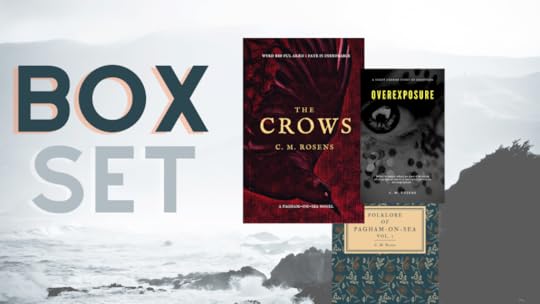
March 14, 2021
From Romancing the Gothic Blog: 100 Women Writers in Horror, the Gothic and Supernatural Fiction from the 18th Century to 2021
An amazing list of 1-100 authors (and I am on the list!! o.O) Please tip at http://www.ko-fi-com/SamHirst if you can. This is such a good resource.

I recently completed a twitter thread on 100 women. You can find it here, if you’re interested. It includes more gifs and pictures! But for ease, I’ve collated them all into one list. The entries are fairly brief but I’m happy to tackle any questions you have! Enjoy the list and if you feel like supporting me or chucking me a tip, there’s a ko-fi and a patreon
1 – 101) Clara Reeve (1729-1807)
Reeve responded to Walpole’s genre starting Castle of Otranto with The Old English Baron (1778). It got rid of excessive supernaturalism and kept the medieval peril. It was originally published as ‘Champion of Virtue’ in reduced circles in 1777.
2) Sophia Lee (1750 – 1824)
Author and playwright, she and her sisters ran a school in Bath. Her Gothically claustrophobic text The Recess (1785) reimagined history, giving Mary, Queen of Scots, two daughters and telling…
View original post 5,048 more words
March 12, 2021
Aesthetic Teasers for THIRTEENTH: see full aesthetics on Twitter @CMRosens
March 11, 2021
Podcast S01E06 ~ Chapter 6 [Part 1 of 2] Today!

The next episode of The Crows is available to listen to on my podcast! This is in 2 parts… Part 1 is up now.
CHAPTER 6: BE CAREFUL WHAT YOU WISH FOR (Part 1 of 2)
Chapter 6: Be Careful What You Wish For (Part 1)…in which Ricky Porter introduces himself, and Carrie finds the priest hole…
Carrie backed off along the hall, breathless and cupping her shaking hand over her mouth as she whispered into the phone.
C. M. Rosens, The Crows, pp. 106-7
“Mercy? Shit, shit, shit…!”
“Carrie?”
“Oh God…”
It scratched at the closed door, dragging claws down the wood. Carrie’s throat constricted as she backed away as silently as she could, fumbling down the paneled hall.
“Carrie, are you okay?”
She forced herself to answer, voice coming out in a scratchy whisper. “It’s in the house, shit it’s in the house, it’s, it’s a dog, or a… I don’t know but it’s bloody huge and it, it’s broken the window, oh my God, it’s in the house…”
The living room doorknob rattled and Carrie stood frozen, every muscle rigid. There was silence.
All Carrie heard was the ticking of the rescued grandfather clock, counting down.
It doesn’t work, Carrie remembered. How can it be ticking?
She lowered the phone, eyes watering, and forced herself to look over her shoulder. The gold pendulum was swinging side-to-side.
Tick.
Tick.
Tick.
The time was still wrong: two minutes to midnight.
A shiver crawled down her back.
The ‘be careful what you wish for’ trope isn’t exclusive to the Gothic, and isn’t really used much in the genre in its literal interpretation. It is more about foreshadowing or foreboding, when characters think ‘oh, this person deserves bad things’, and then bad things happen. Again, not a Gothic-exclusive trope, but something fun to play with in a Gothic horror. I do it a few times in The Crows, but there’s also an actual wishing well, so… be prepared.
What do you think? Head to the Pagham-on-Sea Tourist Board to join the discussion!
March 8, 2021
Author Interview ~ Stefanie Simpson on Romantic Suspense, Disabled Romantic Protagonists, Kink, and Gothic Cosmic Horror Novel WITWORTH DOOM BABY
Stefanie Simpson (she/her) is a coffee-addled, Twitter-addicted, disabled romance author based in the U.K., who has written multiple contemporary romances as well as fantasy romance. Most of her work contains angst, healing and conflict. Expect strong adult content and themes, language, explicit material, love and a HEA [Happy Ever After]. One of her most popular series is The New City Series, but she has also written Paranormal Romance like Demon Beauty, a Beauty and the Beast retelling, and a witchy cosmic horror apocalyptic romance, Witworth Doom Baby. Find her @Simpson_Romance on Twitter and Instagram.
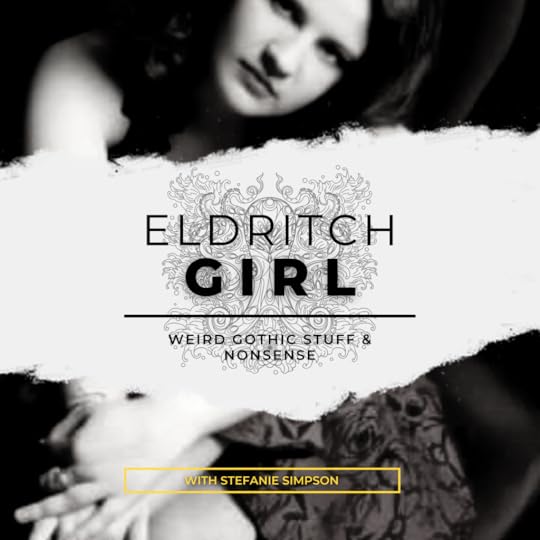
podcast
Listen to this Author Interview episode on my podcast.
Witworth Doom BabyThe death of her mother reveals a dangerous truth about Adaline, more than being a high witch, and the secrets she’s kept for most of her life are no longer in her control. Navigating an immortal war with enemies on all sides, she must decide which path her future will take.
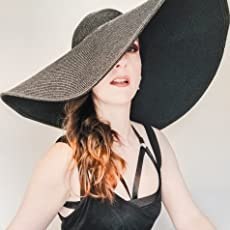 Stefanie Simpson
Stefanie SimpsonOn the precipice of what will come, Adaline doesn’t have time for the strange, alluring investigator, human or not. Yet she knows her fate is tied with his, and she might really be what was prophesied: The Bringer of The End. The real question is whose end? You will not be saved.
A contemporary gothic fantasy, ancient horrors and magic are revealed in a creeping mystery and love story with an introduction by author Micah Chaim Thomas.
Written in British English, this book contains adult themes and material.
CONTENT WARNING: Strong language, frequent bloody horror and gore, war, pandemic, maternal death and estrangement, institutional abuse and coercion, war, supernatural horror, and sexual content.
Interview Transcript (Intro)CMR: Hello, and welcome to Eldritch Girl, and today we’ve got with us Stephanie Simpson who is a romance author. Stephanie is going to be reading an extract from Witworth Doom Baby for us today and we will be chatting about some cosmic horror and romance. Stef, would you like to introduce yourself?
SS: Hello, and thank you for having me on. I’m a disabled British romance writer. I usually write contemporary romance, but I’ve got a few series of self published novels. I also write fantasy romance and apparently cosmic horror, which was you know unexpected.
CMR: that’s how it gets you, it creeps up.
SS: It does, appropriately.
CMR: And so, Witworth Doom Baby! Can you tell us a little bit about the book?
SS: It’s a contemporary Gothic goth-horror and that’s kind of romantic and it apocalyptic end-of-the-world witchy demon strangeness, with portals and cosmic horror.
CMR: That sounds amazing. I have gone I bought it already and it’s on my it’s yeah. I very much enjoyed the bit I’ve got up to. And, so, you’re going to read an extract from it.
SS: I am going to read from the chapter, The Sweetest Lies Carry Our Ghosts, and our main character Adeline has returned to Witworth Manor for whom she works and you don’t quite know who anyone is or what they are, or anything, so we learn a little bit about her in this chapter.
Extract from Witworth Doom Baby (2020)Witworth Manor stood for three hundred years. It took its name from the horror in its foundations. There wasn’t much I was afraid of, but I was of the Manor. The familiar walls welcomed me in, and I tasted the glamour as it whispered to me. It’s a strange power I never mastered. My only skill in bending reality was not being seen, and even then, it was spotty. The ability to control the appearance of places and bodies would have been useful in my work. I swallowed the disdain in my gullet for the pristine history of the place. It was steeped in mystery and righteous servitude for the greater good. It was a load of shit. The cloying smell of lilies from the orangery made my eyes water.
~ Stefanie Simpson
“Well. There you are.” Lady Witworth stood in the great panelled hall and was as old as the manor with her artful white hair coiled on her head. She leant on a cane with her black eyes narrowed.
“She’s definitely dead.”
“You saw her?” The pert, warbling tone echoed.
“Yes. I saw her. Identified the body. I saw the house. Nothing there.” The itch in my mind of what was off sunk in. The cottage where I’d lived had not been lived in. I put that thought aside.
“Good. As it should be.” Lady Witworth tapped along the floor, her cane clinking loudly. I followed. In the library, panelled and filled with the scent of books and dust, the others waited. This was the only room I liked. “We’re ready.” Witworth laughed, taking a small sherry waiting for her. I hoped it had arsenic in it, though I knew it probably wouldn’t kill her, unfortunately. The gangling horrors that made up the Council were already waiting, lounging on leather couches and tall mahogany chairs and their chatter almost sounded happy.
The Council was made up of twelve of some of the oldest witches and separate to our government of Court. The corruption in the Council was complete. They’d fallen one by one over the centuries to the evil they were sworn to defend us against. They’d survived our most brutal war, but I wondered who’d actually won. I bowed my head before looking up. Above the large, old stone fireplace, hung a painting. A woman, classically depicted in flowing white robes with a tit out, stood atop a mountain of skulls.
The Bringer.
I didn’t hold with prophecy or chosen ones. It was a running joke as far as I was concerned. The Bringer, apparently, was to lead the Great Death. No-one really bought into it, seeing as it had been made up some time in the 1920s. Blinking, and feeling old, I turned from the fireplace and poured myself a whisky. “What happens now?”
“We need there to be no impediments.” Lady W’s smug tone grated as I drank.
“Apparently mother had a solicitor and an insurance policy, and I’m being investigated.”
“That might be an issue, do we know who it is?” Grant, the eldest other than Witworth herself, had suspicion in his voice. He’d hated me ever since I stabbed him in the groin for feeling me up when I was younger. I smiled at the memory of his scream and drained the glass.
Lady W shushed them as they murmured. They were rarely all in the same place at the same time and the congregated monsters obeyed. “What next?”
I knew what they’d say. I’d known it when the council secretary called to tell me my mother was dead. “You’re special, Adaline. An important part of our lives and future. This place is a family. Your aunt brought you to us and saved you from your mother. We’ve nurtured and loved you. Now it’s time to repay us and do your duty.” Lady W tapped her cane, and my aunt Matilda came in. My mother had no actual sister, and they looked nothing alike. Her watery eyes were cast down, and she looked frail and unkempt. Another prisoner of this place. I hadn’t seen her in a decade, but I didn’t move. Fear had consumed my childhood, but I’d never understood it until I met Matilda.
“Tell us about the man.” Lady W smirked at me as I stared at Matilda.
I didn’t want to give them his name. “Tell me about my mother.”
Matilda looked up. “Your mother was one of us. When she was of age, as you are now, she was asked to align, and you were the result.”
“My mother was significantly older than me when she went through the Door. Most witches are still honing their powers at my age.”
“But you are not other witches. You are more than a child of the Door. You hide it and think we don’t know. Do you truly understand what you are?”
I took a step back, bile filling my throat.
“Your mother ran away, using her magic, and hid you away from us. She was terrified of you. So we thought it was best you come here where you belong.”
Sweat beaded on my back, and hot ice ran in my blood. To align furthered the Council’s power and connection to the Door. A terrible thing that destroyed my mother, that created me, and corrupted the fabric of our natures. I’d expected my turn since I was a child, but to hear it said upended my control. Pale and hidden from the eyes of others, a figure appeared at my side.
Percival Witworth had been my companion since I arrived. Not many saw the dead, and he was careful to whom he revealed himself. “Well.” He leant his phantom weight on a hip and tilted his head. “I think it’s time to leave.” Long black hair, breeches and shirt, but all translucent and indistinct. A seventeenth-century fuckboi. “You must leave now, or they’ll be no escape, and you’ll become your mother or worse.”
I took a deep breath. Everything I needed was in my car, but there were too many people between me and the exit.
“In fact, the best thing you can do is burn this place to the ground. They think you’re one of them. They believe they’ve done enough for your complicity.” He shimmered. “We talked of this. It is time. You know what will happen to you.”
I did. In the dark, blood-soaked bowels of the Manor, where poorly fitted pipes and rot bloomed, and where no glamour could touch, my trap waited for me. A fear so dark that my mother was no longer the woman I’d seen in a few photos, but a traumatised witch who was terrified of the monster she created. Closing my eyes, I saw myself surrounded by evil, by the coming storm, and I rose from the filth. I would never bow to the fate ordained to me by Witworth and its master on the other side. Yoane had said it. I wonder if they knew she was gone yet. My mind emptied. From a dark recess, my silent companion, so often quelled and silent, took form. It filled my body and took my control. I never let it out or used its terrifying power. I’d kept it so secret that no-one had any thought as to what I was. Its power seeped through, and it was that which my mother feared, not me. The key to my survival had been to give them enough to not suspect. They thought I was as gullible as any weak, human mortal. As if I didn’t know. As if my power wasn’t strong enough to fight back. As if I wasn’t a cold monster made. Pouring another drink with my back turned, the Council chatted among themselves. They whispered of my sacrifice, of how none had come back from the Door in years, and it was never happy.
The end was coming. I was their chosen Bringer. Fuck that.
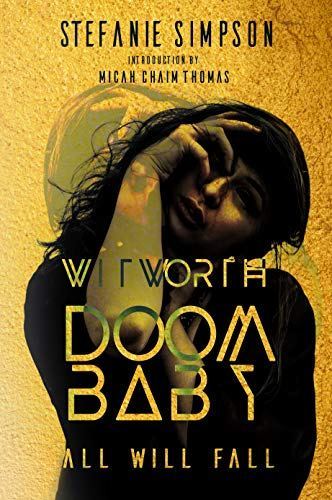 Buy US and UKInterview Transcript
Buy US and UKInterview Transcript CMR: Wow. I love that so much. Yeah so okay, what drew you to pair eldritch cosmic horror with romance or romantic suspense?
SS: I actually started with a title, that… I don’t know where it came from. I just thought, Witworth Doom Baby sounds really cool. And in my head, it was something punk and goth and Gothic and dark. And I kind of didn’t have any world building, I didn’t have a plan for it, I just kind of wrote it in a strange fever dream and serialised it on Wattpad but. The starting point for it came from a short I wrote called The Door, which is no longer on Wattpad because it’s going in something else. That’s about this man who stepped through this mysterious door and comes out something quite different, so that was really like the starting point and this idea of these demons in the dark and these doors and all over the place, and for me it’s very natural to write a romance. I find character arcs are much easier to explore through a relationship that develops so whether that’s like platonic or whatever, it’s just a natural through-line for me to explore a character. And in my head when I was writing I thought it was going to be like a portal PNR [Paranormal Romance] but just a bit Gothic, you know. Yeah I mean just didn’t did not turn out that way it was something very different.
CMR: Okay that’s really cool. What were your main influences for the book?
SS: That’s really tricky because Micah Thomas wrote an intro for it, and he saw a lot of things in it that I did not at all and it made me think a lot about what did influence it. So they might sound a bit disparate, but I kind of really love Hellboy and the comic feels very punk can it’s quite… quite ascerbic and everything, but I also really love Del Toro’s film version of those two films because he’s got this really brutal, glittering, beautiful aesthetic against this really punk dark comic and I just love that juxtaposition of two things, but they work so beautifully together and I guess probably like something like Neverwhere, and like Neil Gaiman’s world building is very fascinating to me. Like this world-within-world idea.
CMR: I love Neverwhere.
SS: Yeah that’s it’s just right there isn’t it and you can’t see until you’re in it, and I feel like kind of this these witches in this world is very much like that, it’s just beyond your sight, but it exists. And actually, this is gonna sound a bit strange, but Henry James and M. R. James, they wrote these like ghost stories right, so that the kind of stories you would tell, and they’re always people telling stories, like third-hand or whatever, but they’re not first-hand stories. Somebody told them the story, and then they tell the story, and Witworth is very much like that. It’s… She’s not telling you this story, this is a second hand version of it. So then, what are the skewed unreliable narration kind of you don’t really know if that’s actually what happened, you know what I mean it’s like yeah.
CMR: yeah, so I think framed narratives as a technique is a really interesting… it’s such a classical Gothic technique as well, it’s such an interesting way of like the Russian doll nested narratives.
SS: Yes, absolutely that’s what it feels like, and I think because she’s not a reliable narrator and you’re seeing a very specific version of events, after the fact, being told to someone else once they’re grown up from being a child experienced it firsthand so there’s this. There’s a skewed perspective and in my head actually Adaline is a very, very small slice of what happens in this big event. She’s a tiny wedge, and she describes herself as a small cog, and she is… she’s a tiny… she is an important cog, but she’s still small cog, and I have all these other stories and other kind of truth around it, so I like that idea that this kind of like slightly skewed perspective it not really being what happens.
CMR: That’s really interesting, I really love that and I’m thinking about the different characters as well, because you’ve got a lot of different… I mean across your work as well you’ve got a lot of different representation and that sort of thing within the… within the narratives, and the different things that you play with and subvert, and I was wondering if we could talk a little bit about those as well. I mean, if you think about like classic Gothic texts and the way that they do very bad representation, especially of like disabled characters who are… that’s a marker of villainy, or like, witches. Yeah and those sorts of tropes that get picked up and perpetrated. Like yeah no. Can we not.
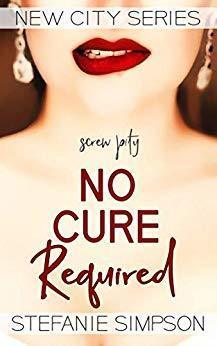 Buy now
Buy nowSS: I mean that there are so few good representations of disabled people and it’s like you’re right we fall into like three categories which is villainy, inspiration or tragedy. So ‘tragedy’ is better off dead, abled character learns a lesson from that death, and then there’s ‘inspo’[inspiration] which is overcoming this kind of, um, or being magically cured from, because obviously it’s so terrible being disabled and it was a long process for me to be able to actually write disabled characters comfortably because we’re all ableist, it’s so indoctrinated interest into us from childhood. And unless you’re actively unlearning those things you’re going to be able to do so and it’s everywhere so.
Romance gets a lot of stick and the thing about romance is that it provides an opportunity to be radical it provides an opportunity to be political. Because you can give a disabled character a happy ever after where they’re loved for who they are without them being expected or asked to overcome anything. They’re not cured. They’re accepted and they are loved and they get a happy ever after. It is radical because that never happens, you know what I mean? So romance is so important for showing people that actually we’re worthy of love, we can be loved, so like in something like No Cure Required, the main character has fibromyalgia which is my chronic illness, and she has a limp, and the pace has to be different and how you construct it has to be different because it’s not an abled narrative, it works on a different level. And we get accused of being kind of inactive because we have to, we can’t necessarily do the things that abled people would do, so it’s a different, it has to be different form of storytelling.
CMR: Are there any particular protagonists are stories that you’re particularly like fond of that you’ve written?
SS: It’s always so hard, these questions.
CMR: They’re your babies!
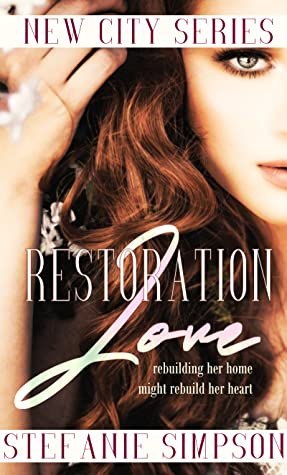 Add to Goodreads
Add to GoodreadsSS: I mean I love… I love Restoration Love because she’s got panic disorder, the main character’s got panic disorder, and she’s a shut-in, she’s kind of agoraphobic and she’s also an artist and she’s kind of… God and I’m like… I relate to her. And she doesn’t get cured. But she finds a good… she gets therapy and medication and she finds ways to cope so it’s a good arc for her.
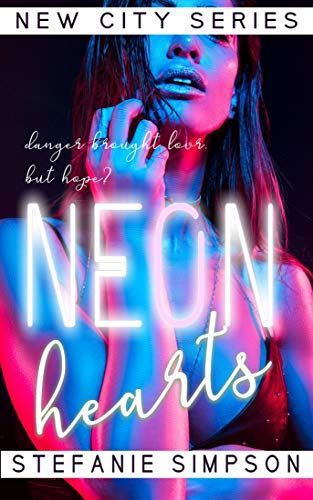 Released on 29 March 2021
Released on 29 March 2021But also there’s a book, my next book coming out, Neon Hearts, both the main characters are disabled and he’s a burns survivor so he’s got facial differences but he’s considered handsome he’s beautiful. And he’s always looked at as gorgeous because he is and like he’s not less so, because of his facial differences and Bea, the female main character, she’s got an acquired brain injury like I do, as I had a TIA [mini stroke], she has a car accident and we follow her through her recovery process, and when we say recovery in this context we don’t need I don’t mean, as in she’s going to get better, you find your new normal it’s, yes, how much can I have you know learning to speak a bit all finding ways to access the world and communicating. So, but I love her because you really follow her through her early journey learning to speak again you know, when she’s mute, and she ends up with a stutter and she forgets words and, at the end and that’s Okay, she’s accepted, she’s not cured but she’s who she is, this is who I am now, and I love that for her.
CMR: yeah that’s yeah that’s a really good way of restructuring narratives yeah. Okay, so another part of that, which shouldn’t be “radical” in inverted commas, but kind of is, is sex and disabled characters or erotica that features disabled characters in a positive way that doesn’t fetishize the disability they have.
SS: Yeah yes. Because there is a lot of that.
CMR: So how kinky is Witworth Doom Baby, I can’t remember if it’s…
SS: If it’s not really. Okay, so not everything I write is heavily kink or culturally kink, but in my head those dynamics play out. So in something like Witworth Doom Baby it’s not like she’s got like a ball gag in her pocket or anything. If it’s needed, you know, I mean she might, I mean there’s all sorts of things in that coat, but you know she doesn’t. And, but she’s very much takes control. She takes what she wants, she’s very dominant, dominating. And Church [the Love Interest] is quite happy to submit to that and then… but what’s interesting about kink and playing with those dynamics is that we can show character development through those things, through those actions, and how they change. So I’m telling you like a lot of character, about who they are as people, you know, and it not necessarily… What what’s the right word… it’s the outside self versus the inside self, it’s your secret self, so what kink does and what those dynamics do is put them on display. So kind of through the narrative some of that switches and some of that changes round, so we see that working in different ways for them so it’s it’s a bit interesting. No it’s not vanilla vanilla, but it’s not got “oh here is a, you know, someone and we’re going to tie you up for them”, not quite kink but it’s not not-kink.
CMR: How does that translate as well into where you are deliberately writing your more kind of erotic romances? I notice you do a lot of femdom, which I love and I think it’s really well done. And yeah I really enjoy those sorts of narratives and how they can be used to develop those dynamics like you said and give characters that agency. But also like it’s okay to be a sub when you’re trying to get your agency back. Because that’s a misconception about that kind of thing, so yeah.
SS: Here’s the thing, so a lot of people have this very, very narrow structure of what they think kink actually is. They think it’s some knob in a suit who is using kink to abuse someone, like that’s really what most people think it is, and it’s kind of reduced to this, almost, sub-genre of dark romance, and it’s not. That’s not what it is. It’s much more fluid and nuanced, and it’s so broad and it’s a natural thing for me to write, like it’s, it’s really natural thing for me to write. It feels very normal and it’s unusual for me to not put kink in it. Because, maybe that doesn’t need to be in it, or it’s not part of that story, but generally it’s something that naturally plays out for me. And what people don’t understand about submission particularly is there’s a lot of power in submission. Because the power comes from: here is an active choice I’m making: my active choice is to give this gift to this person. And that power comes through negotiation, and that power comes through consent.
And one of the things that people don’t understand about kink in real life is, there’s a lot of psychology to it. There’s a lot of inner self put out there, there’s a lot of raw vulnerability. It’s one of the most… healthiest forms of relationships, because people have to talk about things. So what you’re doing when you’re negotiating what you’re doing when you’re going to these places and being vulnerable, and giving permission for these things to happen, and giving sometimes, at some level, agency to somebody else, perhaps; there’s so much power and control in that, even when giving up, there’s a freedom to it that people don’t understand when they have not experienced it.
And something like No Cure Required when Willow [the main character] learns about submission, she finds a freedom in that. An expression of self that she doesn’t have otherwise, and you can find that kind of in different dynamics as well, like in Neon Hearts, Bea finds that, you know she is a fem-domme, and exacting that agency in her life when she has to be passive in many ways, because when you’re disabled, you have to be passive a lot of the time, other people have to make those choices, or other people have to act those actions and you cannot participate other than giving your consent, so for her to retake that power and control over somebody else is a real expression of her agency, as she comes to the close of her narrative.
So you can demonstrate somebody’s inner self, their outer self, and you can give them power or freedom, where they don’t necessarily have it in their stories and their outside self, if that makes sense.
CMR: Yeah yeah. I think that’s a really powerful, interesting dynamic and I love those stories anyway, for, like, I think it just enriches that character arc so much more. So much of it is communication and that constant level of communication that you have to keep up, and that acceptance that actually sometimes what your limits were might change, and that fluidity is something you have to continuously check in with and maybe interrogate a little bit: “for what reasons have my limits changed?” “Why am I now kind of into this or not into this?” “Is this something to do with me, is it to do with my partner? is this, you know what what is this?”
SS: Absolutely, yes.
CMR: You have to be so open about it. And I think yeah and I think you can really tell the difference between books that have been written by somebody who just think kink is a fun, hot, selling point, and people who actually practice kink and like are part of that lifestyle, or or even if it’s not a lifestyle not like, as in a lifestyle that you live 24/7, but like part of that scene.
SS: I get what you mean, exactly.
CMR: Then yeah and it’s really interesting to see the concepts of what people think of as vanilla, even. Because people have conceptions that specific things are vanilla and you know, like, people have different kinds of tolerances and that those sorts of assumptions. And if you’re not in communication with your partner about all of that… which is a very vulnerable thing like, as you say, like it’s it’s a very deep thing. And sometimes you’ll say “Oh, I want you to do this”, or “I like to be called…” or “I like to be insulted” and your partner goes, “I’m not happy doing that…”
SS: Yeah.
CMR: “…for these reasons…”, and you have to then negotiate all that.
SS: Exactly: what am I prepared to go, where am I not prepared to go, which words are okay, which words are not Okay, and if you’re getting into real kind of specific nuances of tone of voice even. In the context for those things like, Kink A might be appropriate at this point, but it’s not appropriate at a slightly different point. There can be such really, really careful nuances. So, finding a through-thread for a story where it plays out is actually really easy for me, as far as the kink goes. Like once I find that line of kink, I know exactly what they are, and who they’re going to be and how it’s gonna play out for them. And sometimes I’ll write something and it’s kind of in there until I put the kink into it, and I’m like oh, that makes sense now. Do you know what I mean? It makes it kind of hold whole and complete, because you like you say you have to deal with that psychology definitely, yeah.
CMR: Yeah it’s such an interesting topic, it was probably talk about this for four hours. For ages. Forever. But um yeah so Neon Hearts is your next one that’s coming out.
SS: It is. I’m very excited. It’s the last book in a nice in the New City series there’s still a New City story to finish off, but this is the last main novel in the series.
CMR: How’d you feel about that?
SS: It’s bittersweet. I’m … I need to be done, like I’m ready for it to be finished. Because there are other things I want to write down and maybe kind of get off the treadmill of self publishing for a while. But kind of sad because I’ve spent… I’ve been with writing these since 2016 so. That’s a long time.
CMR: Yeah, when is Neon Hearts, when is the launch date for that?
SS: It’s out on the 29th of March. I’m very excited.
CMR: Exciting times, that’s great. So what do you think you will do after that?
SS: I’m going to watch a lot of Netflix.
CMR: Haha, good.
SS: And I’ve got a few other things to finish off for a New City story. It’s another disabled… it’s a polyamorous triad… it’s going to be delightful. It’s just 40,000 words of filth, it’s brilliant. Now that’s that and that’s going to be the last one, then we’re all done. And then I’ve got a secret project I’m working on with someone else, which might have something to do with Witworth Doom Baby, but I can’t tell you anything else about that.
CMR: Exciting times.
SS: (whispers) Oh it’s very exciting.
SS: And I’ve got a PNR [Paranormal Romance] I’m kind of working on, And Broody… but here’s the thing, though, because I don’t feel I can write anything contemporary anymore, because i’ve got you’ve got to put in kind of COVID and I don’t really want to, so in my head, I thought, well, I just set it in the 90s that’s close enough so everything now is going to be set in the 90s, so I’m just kind of bringing it to a broody two-hander.
CMR: The 90s has a really good aesthetic though I think it’s an underappreciated decade.
SS: Yeah, and it was my decade, okay, because that’s when I was a teenager so.
CMR: Same.
SS: You, yeah I’ve got a nice broody two-hander romance [a romance with two main characters who are each given equal weight through the story] kind of sitting on the back burner so I’m going to get into those when I, when I, when I want to, no pressure, just yeah, yeah, lots of rest.
CMR: Exciting. The rest is very exciting.
SS: Oh I’m looking forward to it, I really am.
CMR: Well, I hope that your launch day is very successful and that you get a load of pre-orders, and by the time this is coming out so yours is a March interview, so it’s just in time for your big announcement. So that’ll be good, and thank you so much for coming on the show it’s been really great to have you.
SS: And thank you for having me it’s been really fun, I was so nervous about doing this, but it was great. Thank you so much.
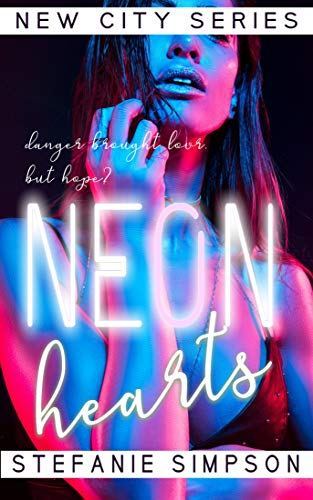 The last novel in the New City Series, released 29 March 2021
The last novel in the New City Series, released 29 March 2021
 Available Now
Available Now

 Wintry Wiltshire Gothic ~ in pictures
Wintry Wiltshire Gothic ~ in pictures 

